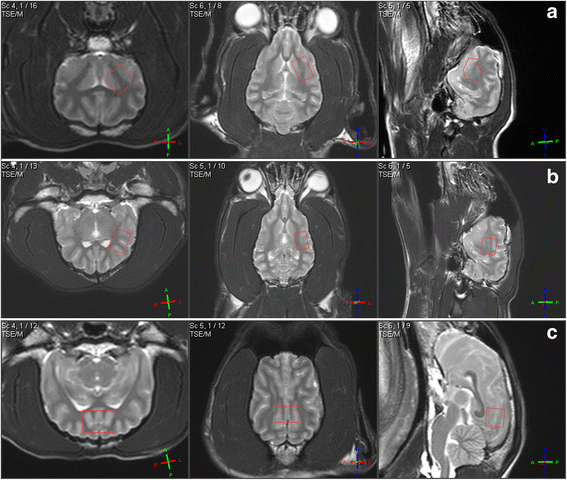Effects of isoflurane, sevoflurane, propofol and alfaxalone on brain metabolism in dogs assessed by proton magnetic resonance spectroscopy (1H MRS)
- PMID: 29506576
- PMCID: PMC5839062
- DOI: 10.1186/s12917-018-1396-1
Effects of isoflurane, sevoflurane, propofol and alfaxalone on brain metabolism in dogs assessed by proton magnetic resonance spectroscopy (1H MRS)
Abstract
Background: The purpose of this study was to determine the effects of isoflurane, sevoflurane, propofol and alfaxalone on the canine brain metabolite bioprofile, measured with single voxel short echo time proton magnetic resonance spectroscopy at 3 Tesla. Ten adult healthy Beagle dogs were assigned to receive isoflurane, sevoflurane, propofol and alfaxalone at 3 different dose rates each in a randomized cross-over study design. Doses for isoflurane, sevoflurane, propofol and alfaxalone were FE'Iso 1.7 vol%, 2.1 vol%, 2.8 vol%, FE'Sevo 2.8 vol%, 3.5 vol% and 4.7 vol%, 30, 45 and 60 mg kg- 1 h- 1 and 10, 15 and 20 mg kg- 1 h- 1 respectively. A single voxel Point Resolved Spectroscopy Sequence was performed on a 3 T MRI scanner in three brain regions (basal ganglia, parietal and occipital lobes). Spectral data were analyzed with LCModel. Concentration of total N-acetylaspartate (tNAA), choline, creatine, inositol and glutamine and glutamate complex (Glx) relative to water content was obtained. Plasma concentration of lactate, glucose, triglycerides, propofol and alfaxalone were determined. Statistics were performed using repeated measures ANOVA or Wilcoxon Sign Rank test with alpha = 5%.
Results: Plasma glucose increased with isoflurane, sevoflurane and alfaxalone but decreased with propofol. Plasma lactate increased with all anesthetics (isoflurane > sevoflurane > propofol > alfaxalone). Cerebral lactate could not be detected. Only minor changes in cerebral metabolite concentrations of tNAA, choline, inositol, creatine and Glx occurred with anesthetic dose changes.
Conclusion: The metabolomic profile detected with proton magnetic resonance spectroscopy at 3 Tesla of canine brain showed only minor differences between doses and anesthetics related to tNAA, choline, creatine, inositol and Glx.
Keywords: Anesthesia; Canine; Cerebral; Glucose; Lactate; LcModel; MRI; PRESS; Plasma.
Conflict of interest statement
Ethics approval
All animal procedures were reviewed and approved by the ethical committee for animal experimentation of the Federal State Office for Consumer Protection and Food Safety of Lower Saxony, Germany (3392 42,502–04-13/1252) according to the German animal protection law.
Consent for publication
Not applicable.
Competing interests
MGR and KP are employed by Jurox Pty Ltd.
Publisher’s Note
Springer Nature remains neutral with regard to jurisdictional claims in published maps and institutional affiliations.
Figures




Similar articles
-
Effects of intravenous administration of tiletamine-zolazepam, alfaxalone, ketamine-diazepam, and propofol for induction of anesthesia on cardiorespiratory and metabolic variables in healthy dogs before and during anesthesia maintained with isoflurane.Am J Vet Res. 2019 Jan;80(1):33-44. doi: 10.2460/ajvr.80.1.33. Am J Vet Res. 2019. PMID: 30605029
-
Effects of hypotension and/or hypocapnia during sevoflurane anesthesia on perfusion and metabolites in the developing brain of piglets-a blinded randomized study.Paediatr Anaesth. 2016 Sep;26(9):909-18. doi: 10.1111/pan.12956. Epub 2016 Jun 27. Paediatr Anaesth. 2016. PMID: 27345010
-
Effects of alfaxalone, propofol and isoflurane on cerebral blood flow and cerebrovascular reactivity to carbon dioxide in dogs: A pilot study.Vet J. 2023 Jan;291:105939. doi: 10.1016/j.tvjl.2022.105939. Epub 2022 Dec 9. Vet J. 2023. PMID: 36509393
-
New progress of isoflurane, sevoflurane and propofol in hypoxic-ischemic brain injury and related molecular mechanisms based on p75 neurotrophic factor receptor.Ibrain. 2021 Jun 28;7(2):132-140. doi: 10.1002/j.2769-2795.2021.tb00075.x. eCollection 2021 Jun. Ibrain. 2021. PMID: 37786902 Free PMC article. Review.
-
Brain proton magnetic resonance spectroscopy of alcohol use disorders.Handb Clin Neurol. 2014;125:313-37. doi: 10.1016/B978-0-444-62619-6.00019-7. Handb Clin Neurol. 2014. PMID: 25307583 Free PMC article. Review.
Cited by
-
General technical remarks on 1HMRS translational research in 7T.Pol J Radiol. 2019 Apr 12;84:e190-e197. doi: 10.5114/pjr.2019.85147. eCollection 2019. Pol J Radiol. 2019. PMID: 31481990 Free PMC article.
-
Effects of Sevoflurane Pretreatment on Myocardial Ischemia-Reperfusion Injury Through the Akt/Hypoxia-Inducible Factor 1-alpha (HIF-1α)/Vascular Endothelial Growth Factor (VEGF) Signaling Pathway.Med Sci Monit. 2019 Apr 27;25:3100-3107. doi: 10.12659/MSM.914265. Med Sci Monit. 2019. PMID: 31028241 Free PMC article.
-
Effects of sevoflurane anesthesia and abdominal surgery on the systemic metabolome: a prospective observational study.BMC Anesthesiol. 2021 Mar 17;21(1):80. doi: 10.1186/s12871-021-01301-0. BMC Anesthesiol. 2021. PMID: 33731015 Free PMC article.
-
Canine metabolomics advances.Metabolomics. 2020 Jan 18;16(2):16. doi: 10.1007/s11306-020-1638-7. Metabolomics. 2020. PMID: 31955274 Review.
-
Ketamine administration in idiopathic epileptic and healthy control dogs: Can we detect differences in brain metabolite response with spectroscopy?Front Vet Sci. 2023 Jan 6;9:1093267. doi: 10.3389/fvets.2022.1093267. eCollection 2022. Front Vet Sci. 2023. PMID: 36686158 Free PMC article.
References
Publication types
MeSH terms
Substances
LinkOut - more resources
Full Text Sources
Other Literature Sources

